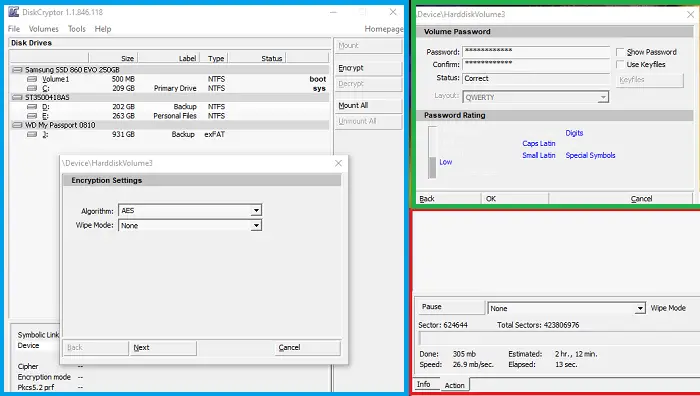Windows 10 offers an integrated encryption solution – BitLocker – which ensures that the drive, if used elsewhere, will not be readable. However, like many other solutions, it is a proprietary solution. If you’re looking for an alternative to BitLocker, an open source encryption solution, then check out DiskCryptor. You can use it to encrypt disk partitions, including the system partition.
DiskCryptor disk encryption software for Windows 10
Before you start, DiskCryptor is not new. According to the current developer, it was developed to replace the DriveCrypt Plus Pack and PGP WDE with NTLDR. However, there has been no development since 2014, so the guys at diskcryptor.org took software development into their own hands (GNU GPLv3). The good news is that software development seems to be active on their GitHub page, so you can use it if you’re looking for an alternative.
DiskCryptor features
- Support for AES, Hardware AES, Twofish, Serpent encryption algorithms individually or in combination.
- SSD TRIM is supported.
- Transparent encryption of disk partitions.
- Full support for dynamic disks.
- It works with all RAID volumes supported by the system, that is, it supports disks with large sector sizes.
- Compatible with multiple boot managers, UEFI / GPT boot, third-party boot loaders (LILO, GRUB, etc.)
- Possibility to place the bootloader on an external support and to authenticate using the key support.
- Support for key files.
- Besides storage devices, it works with CDs, DVDs and external USB storage devices.
- It can also automatically mount disk partitions and external storage devices.
- Support for keyboard shortcuts and optional command line interface (CLI).
- Open the GNU GPLv3 license.
Once encryption is complete, the partition or volume can no longer be used to identify data. It will be password protected, and once you enter the password, the partition structure will become accessible.
How to use DiskCryptor

- Once you launch the software, it will reveal all the partitions sorted by the physical disk.
- Select one of the partitions and right click, then click on Encrypt
- Next, you need to select the encryption algorithm and cleaning mode.
- In the next step, you can configure a password or use a key file.
- Finally, start the encryption and wait for it to finish.
The password can be changed. Right-click on the mounted volume and choose to to change the password in the context menu.
The total time required for encryption depends on the speed and size of the drive. If you encrypt the primary partition, you will need to enter the password during the boot process. That said, here are two cool features of DiskCryptor that you should know about.
DiskCryptor erase mode
Note that when you use Wipe mode during encryption, it does not delete the files and residual data that a file system may contain. According to the developers, this is not necessary because the program encrypts the entire file system. Wipe mode instead prevents the possibility of recovering data by examining the residual magnetic energy, which can be done on specialized equipment.
Pause, resume encryption anywhere
This feature allows you to suspend the ongoing encryption process and resume later. Not only that, if you use it, you can also decrypt an incomplete encryption. This is handy if you accidentally chose the wrong drive for encryption and don’t want to wait long hours. In addition, if you encrypt an external drive, you can suspend and then fail over the computer and start encryption on another computer.
Although you should be able to perform all kinds of disk management after encrypting the device, software developers do not recommend this. This is mainly because the software has not been tested for such scenarios.
You can download it from GitHub. After installation, you will need to restart the computer before you can use the software. If you plan to uninstall, be sure to decrypt all volumes, especially the system partition.
